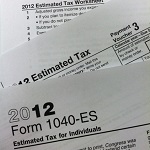 When was the last time you thought income taxes? It was probably in April unless you are a small business owner. Small business owners and other independent contractors think about taxes all year long because of quarterly estimates.
When was the last time you thought income taxes? It was probably in April unless you are a small business owner. Small business owners and other independent contractors think about taxes all year long because of quarterly estimates.
Who Must Pay Estimated Tax
If you owed additional tax for 2011, you may have to pay estimated tax for 2012.
You can use the following general rule as a guide during the year to see if you will have enough withholding, or should increase your withholding or make estimated tax payments.
General Rule
In most cases, you must pay estimated tax for 2012 if both of the following apply.
- You expect to owe at least $1,000 in tax for 2012, after subtracting your withholding and refundable credits.
- You expect your withholding and refundable credits to be less than the smaller of:
- 90% of the tax to be shown on your 2012 tax return, or
- 100% of the tax shown on your 2011 tax return. Your 2011 tax return must cover all 12 months.
Note: Farmers, fishermen and high income taxpayers have special rules.
How To Figure Estimated Tax
To figure your estimated tax, you must figure your expected Adjusted Gross Income (AGI), taxable income, taxes, deductions, and credits for the year.
When figuring your 2012 estimated tax, it may be helpful to use your income, deductions, and credits for 2011 as a starting point. Use your 2011 federal tax return as a guide. You can use Form 1040-ES to figure your estimated tax.
You must make adjustments both for changes in your own situation and for recent changes in the tax law. For 2012, there are several changes in the law. For information about these and other changes in the law, visit the IRS website at www.IRS.gov.
The instructions for Form 1040-ES include a worksheet to help you figure your estimated tax. Keep the worksheet for your records.
When To Pay Estimated Tax
For estimated tax purposes, the year is divided into four payment periods. Each period has a specific payment due date. If you do not pay enough tax by the due date of each of the payment periods, you may be charged a penalty even if you are due a refund when you file your income tax return.
If a payment is mailed, the date of the U.S. postmark is considered the date of payment. The payment periods and due dates for estimated tax payments are shown next. For exceptions to the dates listed, see Saturday, Sunday, holiday rule below.
| For the period: | Due date: |
| Jan. 1 – March 31 | April 15 |
| April 1 – May 31 | June 15 |
| June 1 – August 31 | September 15 |
| Sept. 1 – Dec. 31 | January 15 next year |
Saturday, Sunday, holiday rule. If the due date for an estimated tax payment falls on a Saturday, Sunday, or legal holiday, the payment will be on time if you make it on the next day that is not Saturday, Sunday, or a holiday.
How To Pay Estimated Tax
There are five ways to pay estimated tax.
- Credit an overpayment on your 2011 return to your 2012 estimated tax.
- Send in your payment (check or money order) with a payment voucher from Form 1040-ES.
- Pay electronically using the Electronic Federal Tax Payment System (EFTPS).
- Pay by electronic funds withdrawal (EFW) if you are filing Form 1040 or Form 1040A electronically.
- Pay by credit or debit card using a pay-by-phone system or the Internet.
Pay by Check or Money Order Using the Estimated Tax Payment Voucher
Each payment of estimated tax by check or money order must be accompanied by a payment voucher from Form 1040-ES. If you use your own envelopes (and not the window envelope that comes with the 1040-ES package), make sure you mail your payment vouchers to the address shown in the Form 1040-ES instructions for the place where you live.
Pay Electronically
For information on paying your estimated taxes electronically, including by Electronic Federal Tax Payment System, Electronic funds withdrawal, or credit or debit card, go to www.irs.gov/e-pay.
Need Help?
If would like assistance to figure how much your estimated tax payments should be, please contact us. That is what we are here for!






